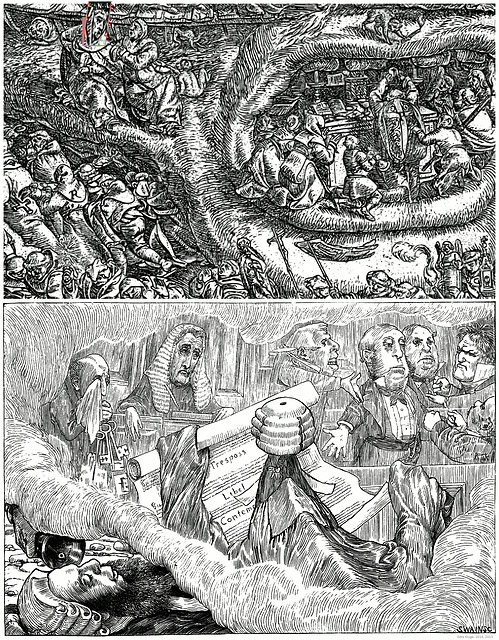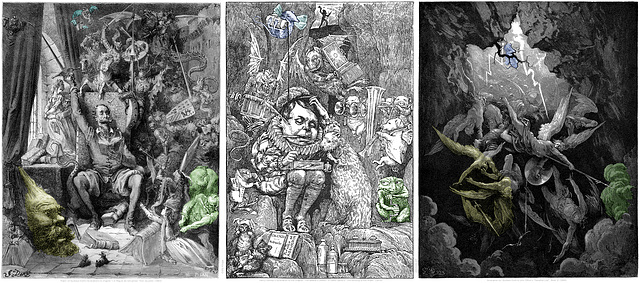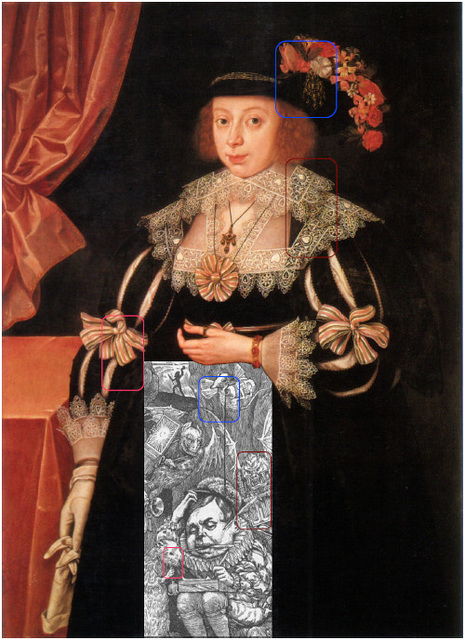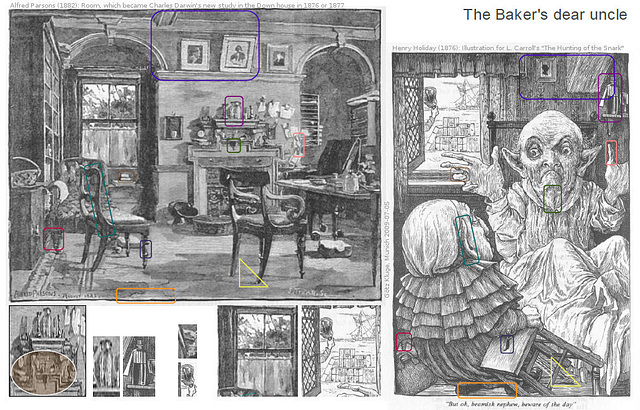
Topological Match
Folder: The Hunting of the Snark
20 Mar 2014
2 comments
Two Bone Players
[left]: Segment from an Illustration by Henry Holiday to Lewis Carroll's The Hunting of the Snark (1876).
[right, mirror view]: The Bone Player (1856) by William Sidney Mount, now displayed in MFA, Boston.
See also: www.academia.edu/9889413/The_Bankers_Face
18 Jan 2014
2 comments
The Broker's and the Monk's Nose (with a little help)
[left]: Segment from an illustration by Henry Holiday to Lewis Carroll's The Hunting of the Snark depicting the Broker (upper left corner). The object he is holding at his lips is the handle of a malacca walking cane, a gesture associated with dandies in the Victorian era.
[right]: Segment from anonymous: Edward VI and the Pope , a Tudor anti-papal allegory of reformation (16th century).
Holidays Snark illustrations are conundrums. And they were constructed as conundrums. The colored boxes are meant as a little help to you. There is not only a relation between the patterns marked by the same color, also the topological relation between the patterns on the left side and the right side show some similarity.
The pattern in the orange frame on the lower left side clearly is an allusion to a rather unobtrusive pattern on the right side. This shows that Holiday did not "copy" patterns just because of they would contribute to the impressiveness of his illustrations. Holiday is not a plagiarist.
·
In 1922 (46 years after The Hunting of the Snark was published), Henry Holiday (the illustrator) wrote to George Sutcliffe (Sangorski & Sutcliffe, bookbinders, London): "... you will notice that the Broker in [the proof of the illustration to The Crew on Board ] no. 5 is quite different to the one in [ the later proof ] no. 2. I had intended to give a caricature a the vulgar specimen of the profession, but Lewis Carroll took exception to this and asked me to treat the head in a less aggressive manner, and no. 2 is the result. I consider that no. 5 has much more character, but I understood L. Carroll's objection and agreed to tone him down. ..."
Charles Mitchel called the first design of the broker's face in the lower right corner of the print "conspiciously antisemitic". The change of the printing blocks must have been very important to Carroll, as it took the wood cutter Swain quite some effort to implement that change (see p. 102, Lewis Carroll's The Hunting of the Snark , 1981 William Kaufmann edition).
As shown in the image above, the broker's face also appears in the upper left section of Holiday's illustration to The Hunting . Rather than by a "Semitic" face, Holiday may have been inspired by what could be a cliché of the face of a roman catholic monk depicted in the 16th century anti-papal painting Edward VI and the Pope .
·
Links:
※ www.reddit.com/r/museum/comments/4lrs3o/anonymous_king_edward_vi_and_the_pope_estimates
※ www.reddit.com/r/TheHuntingOfTheSnark/comments/3ul02u/the_brokers_and_the_monks_nose
※ www.academia.edu/9890076/The_Broker_and_the_Monk
※ www.facebook.com/snark150/posts/1647429028620386
11 Apr 2012
1 favorite
3 comments
Holiday - Millais - Anonymous - Galle
See also: www.academia.edu/9856486/Henry_Holiday_-_and_Millais_Christ_in_the_House_of_His_Parents_
.
The discovery here is the allusion by Henry Holiday to the painting by J.E. Millais. Finding Millais' allusions to an anonymous painter and to Galle's print is a "bycatch" of my Snark hunt. The relation between the anonymous painting and Galle's print already has been explained by Margaret Aston in 1994. That relation brobably has been discovered even earlier by Millais.
.
[left]: Henry Holiday: Depiction (1876) of the Baker's visit to his uncle in Lewis Carroll's " The Hunting of the Snark " (engraved by Joseph Swain). Outside of the window are some of the Baker's 42 boxes.
[right top]: John Everett Millais : Christ in the House of His Parents aka The Carpenter's Shop (1850).
Location: Tate Britain (N03584) , London.
Literature:
* Deborah Mary Kerr (1986): John Everett Millais's Christ in the house of his parents ( circle.ubc.ca/handle/2429/26546 )
* p.34 in (01) Éva Péteri (2003): Victorian Approaches to Religion as Reflected in the Art of the Pre-Raphaelites, Budapest 2003, ISBN 978-9630580380 (shortlink: www.snrk.de/EvaPeteri.htm )
* Albert Boime (2008): Art in an Age of Civil Struggle, 1848-1871
p. 225-364: The Pre-Raphaelites and the 1848 Revolution ( en.wikipedia.org/wiki/Special:BookSources/0226063283 )
[right middle]: Anonymous : Edward VI and the Pope , An Allegory of Reformation, mirrored view (16th century, NPG 4165 ). Iconoclasm depicted in the window. Under the "window" 3rd from left is Thomas Cranmer who wrote the 42 Articles in 1552.
Edward VI and the Pope (NPG 4165) was, until 1874, the property of Thomas Green, Esq., of Ipswich and Upper Wimpole Street , a collection 'Formed by himself and his Family during the last Century and early Part of the present Century' (Roy C. Strong: Tudor and Jacobean Portraits , 1969, p.345). Thus, when Millais' Christ in the House of His Parents ('The Carpenter's Shop') was painted in 1849-1850, the 16th century painting was part of a private collection. It was sold by Christie's 20 March 1874 (lot 9) to a buyer unknown to me, that is, when Holiday started with his illustrations to The Hunting of the Snark .
Location: National Portrait Gallery, London
[right bottom]: Philip Galle after Maarten van Heemskerck , Redrawn print Ahasuerus consulting the records (1564). The resemblance to the image above (right middle) was shown by Dr. Margaret Aston in 1994 in The King's Bedpost: Reformation and Iconography in a Tudor Group Portrait (p. 68). She also compared the bedpost to Heemskerck's Esther Crowned by Ahasuerus .
Location: Rijksmuseum, Amsterdam
23 Jun 2013
5 comments
The Snark in your Dreams
The lower image is the only Snark illustration by Henry Holiday which shows the Snark . However, in this case the beast appeared in The Barrister's dream . Therefore it is just a Dream Snark .
[top]: Detail from the etching (1566-1568) The Image Breakers by Marcus Gheeraerts the Elder.
[bottom]: Detail from the illustration (1876) by Henry Holiday to The Hunting of the Snark . Lewis Carroll (C. L. Dodgson) did not want Henry Holiday to depict the Snark in the illustrations to The Hunting of the Snark . But Holiday was allowed to let it appear veiled by its "gown, bands, and wig" in The Barrister's Dream .
Also in this case, Holiday pictorially alluded to the etching by Marcus Gheeraerts the Elder. In this comparison several shapes - see notes (1) to (5) - provide the beholder of the illustration with pictorial quotes which point to that etching.
This is just the place to repeat a textual quote which I like a lot:
"We have neglected the gift of comprehending things through our senses. Concept is divorced from percept, and thought moves among abstractions. Our eyes have been reduced to instruments with which to identify and to measure; hence we suffer a paucity of ideas that can be expressed in images and in an incapacity to discover meaning in what we see. Naturally we feel lost in the presence of objects that make sense only to undeluted vision, and we seek refuge in the more familiar medium of words. ... The inborn capacity to understand through the eyes has been put to sleep and must be reawakened."
(Rudolf Arnheim: Art and Visual Perception, 1974, p. 1)
Images like this could be used in class by arts teachers to reawaken that inborn capacity. This also is a training to make and discuss decisions based on incomplete information.
Am I wrong? Am I right?
"Only those questions that are in principle undecidable, we can decide."
(Heinz von Foerster: Ethics and Second-Order Cybernetics, 1990-10-04, Système et thérapie familiale, Paris)
·
2014-05-19
30 Jan 2009
2 comments
The Bankers Fate
My first comparison related to The Banker (2009). After more than one year I suddenly understood Holiday's nose job:
07 Jan 2013
3 favorites
4 comments
Doré (1863), Holiday (1876), Doré (1866)
=== Henry Holiday's Allusions ===
The comparison shows illustrations [right side] by Gustave Doré (to John Milton's Paradise Lost , Book VI, 1866), [left side] Plate I of Gustave Doré's illustrations to chapter 1 in Miguel de Cervantes' Don Quixote (1863 edition) and [center] by Henry Holiday (to The Hunting of the Snark , 1876).
Probably also this applies: Doré (1863) -> Doré (1866). Why shouldn't a prolific artist re-use his own work?
See also: www.academia.edu/9920080/Henry_Holiday_and_Gustave_Dor%C3%A9_borrowing_from_Gustave_Dor%C3%A9
=== Safety at the Workplace ===
The story how I run into The Hunting of the Snark" is has been moved to this image:
www.ipernity.com/doc/goetzkluge/34431511
06 Jun 2013
1 favorite
4 comments
Anne Hale Mrs. Hoskins
Anne Hale, Mrs Hoskins (1629) by Marcus Gheeraerts the Younger and a segment (mirror view) of an illustration by Henry Holiday (cut by Joseph Swain) to Lewis Carroll's The Hunting of the Snark (1876)
20 Aug 2011
3 comments
The Bellman and Sir Henry Lee
The Bellman (segment of an illustration by Henry Holliday to Lewis Carroll's The Hunting of the Snark ) and a mirrored view of an unfinished portrait of Sir Henry Lee by Marcus Gheeraerts the Younger
Yes, the noses and the eyes are different. This is not a face comparison. In this case, Holiday's pictorial allusions refer to the surroundings of Lee's face, not to the face itself. As in several other cases, Holiday maintained the topological relation between the quoted shapes. Here the shapes are the nodes in two quite similar graphs.
Holiday even "copied" the cracks in the varnish of Gheerert's painting.
05 Jul 2009
1 favorite
2 comments
Darwins snarked Study
Alfred Parsons' depiction of Charles Darwin's study in Downe. The wood cutter was J. Tynan.
I assume that Alfred Parsons quoted shapes from Henry Holiday's illustration (cut by Joseph Swain) to The Bakers Tale in Lewis Carroll's The Hunting of the Snark in a similar manner as Henry Holiday used shapes in the works of earlier artists perhaps in order to "point" to these works. The match of each single shape could be quite incidental, but the the spacial relation of most shapes to each other also matches well. That is less likely to be just incidental.
(Alfred Parsons' depiction of Charles Darwin's new study is used here with permission by Dr. John van Wyhe, darwin-online.org.uk/. Henry Holiday's illustration has been scanned from a book published in 1911.)
This is one of the images which I posted on Flickr a few years ago. It is an earlier version of the image below:
Jump to top
RSS feed- Latest items - Subscribe to the latest items added to this album
- ipernity © 2007-2024
- Help & Contact
|
Club news
|
About ipernity
|
History |
ipernity Club & Prices |
Guide of good conduct
Donate | Group guidelines | Privacy policy | Terms of use | Statutes | In memoria -
Facebook
Twitter










